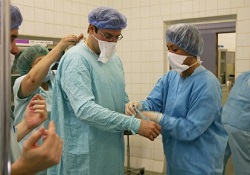 When properly diagnosed and treated, jaundice (also known as Hyperbilirubinemia) is essentially harmless. It’s a fairly common condition in newborns, with some studies finding that as many as one in four infants have some level of jaundice. It’s caused by an overabundance of a protein—bilirubin—in the blood of a new baby, and is usually effectively treated with ultraviolet light. However, if not properly treated, it may build up to such a level that the protein stays in the brain cell of the infant, causing permanent brain damage (a condition known as “kernicterus”).
When properly diagnosed and treated, jaundice (also known as Hyperbilirubinemia) is essentially harmless. It’s a fairly common condition in newborns, with some studies finding that as many as one in four infants have some level of jaundice. It’s caused by an overabundance of a protein—bilirubin—in the blood of a new baby, and is usually effectively treated with ultraviolet light. However, if not properly treated, it may build up to such a level that the protein stays in the brain cell of the infant, causing permanent brain damage (a condition known as “kernicterus”).
Studies show that all babies are at risk of jaundice immediately after birth. A premature birth may increase the risk of higher bilirubin levels, and research has shown that baby boys are more susceptible to the condition.
Though jaundice physically manifests in a yellow tint to the child’s skin (the condition is often referred to as “yellow jaundice”), all new babies should, as a matter of course, have bilirubin levels tested before leaving the hospital. It’s a simple blood test, usually done with a prick to the infant’s foot. If bilirubin levels are unacceptably high, the child should receive treatment at the hospital. It’s also customary to send a child home with portable UV lights, and have a home health care worker stop by and check the child’s levels on a daily basis.
If your child has been diagnosed with jaundice and is discharged to go home, he or she should have a scheduled follow-up with your treating physician, ideally within two days of leaving the hospital. It can also be beneficial to your child to be exposed to as much natural light as possible, so placing your child’s crib with exposure from natural sunlight (by a window) can be helpful. Many doctors will also recommend that you suspend breastfeeding until your child’s bilirubin levels have returned to acceptable levels.
Contact Us
At Taylor & Boguski, we bring more than 70 years of combined legal experience to people throughout New Jersey. For a free initial consultation, contact our office online or call us at 856-200-8989.


 When you are giving birth to a child, there’s always the possibility that, once the baby’s head is out of the birth canal, one of its shoulders will get caught on your pubic bone, a condition known as “Shoulder Dystocia.” If your delivering physician fails to take appropriate steps, your child can suffer very serious consequences, including damage to the brachial plexus nerves that control the shoulder, arms, hands and fingers. This can lead to loss of use or paralysis. In rare situations, shoulder Dystocia may impede the flow of blood and oxygen, causing brain damage, cerebral palsy or even death.
When you are giving birth to a child, there’s always the possibility that, once the baby’s head is out of the birth canal, one of its shoulders will get caught on your pubic bone, a condition known as “Shoulder Dystocia.” If your delivering physician fails to take appropriate steps, your child can suffer very serious consequences, including damage to the brachial plexus nerves that control the shoulder, arms, hands and fingers. This can lead to loss of use or paralysis. In rare situations, shoulder Dystocia may impede the flow of blood and oxygen, causing brain damage, cerebral palsy or even death. If your marriage isn’t working, the typical response is to legally end it by
If your marriage isn’t working, the typical response is to legally end it by  Kids just love to ride a bike, but statistics show that
Kids just love to ride a bike, but statistics show that